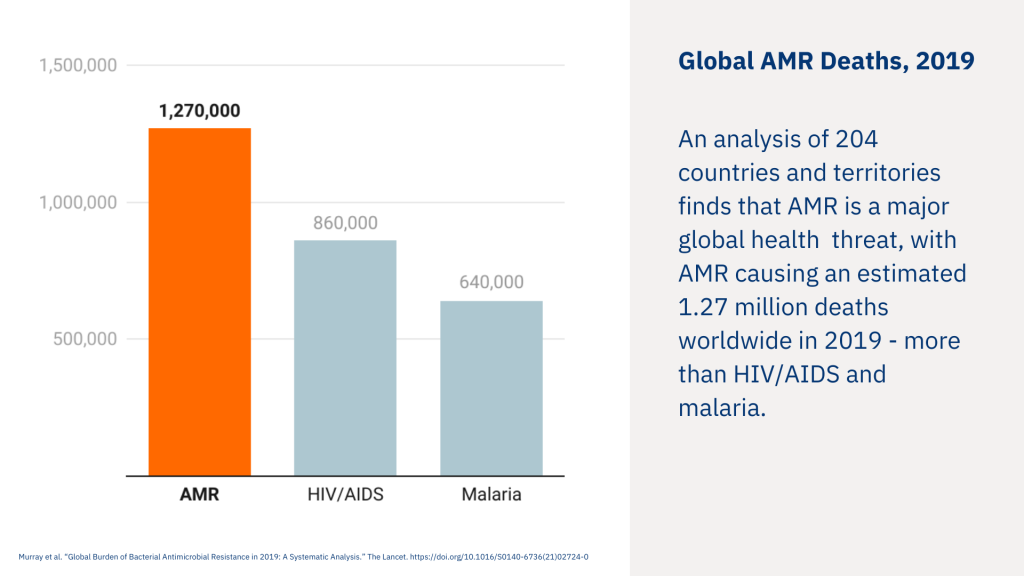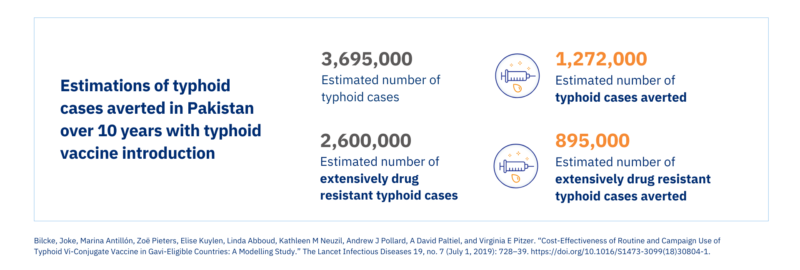
Antimicrobial resistance (AMR) is a growing threat to the health of children worldwide. New evidence shows how vaccines are one promising way to combat the global spread of AMR. New research on typhoid conjugate vaccines (TCV) shows how immunization can protect children, families, and communities against the emergence of dangerously resistant superbugs.
Key Messages
- WHO has declared that AMR is one of the top 10 global public health threats facing humanity.
- With the identification of increasingly treatment-resistant typhoid strains, we are dangerously close to running out of options for oral antibiotic treatments.
- Vaccines contribute to the battle against antimicrobial resistance (AMR) by preventing infections and by reducing the use of antibiotics.
Antimicrobial resistance (AMR) is one of the most urgent threats currently facing global health. Antimicrobials are medicines used to prevent and treat infections in humans, animals and plants and include antibiotics, antivirals, antifungals and antiparasitics. AMR occurs when bacteria, viruses, fungi, and parasites evolve over time and no longer respond to antimicrobial medicines. When pathogens become drug resistant, antibiotics and other antimicrobial medicines become ineffective and infections become increasingly difficult or impossible to treat leading to more severe illness and risk of death.
Vaccines already save millions of lives every year by preventing infectious diseases like pneumonia and diarrhea. However, new research provides evidence that vaccines are an important tool in preventing the spread of AMR. For World Antimicrobial Awareness Week (WAAW)(18-24 November) the VoICE team is highlighting the important role of vaccines in saving lives and combating antimicrobial resistance.
According to a 2019 UNICEF report, “The emergence and spread of AMR is occurring at an alarming rate with current estimates indicating that at least 700,000 people die worldwide each year due to drug-resistant infections, which is expected to rise to 10 million deaths globally by 2050.”
AMR is a Major Threat to Child Survival
“Vaccines are among the most effective tools to prevent infections, and they have the potential to make a major contribution to the control and prevention of AMR.” – World Health Organization, 2020
AMR is a leading cause of death around the world, with the highest burdens in low-resource settings. A Lancet analysis of the health impacts of AMR across 200 countries and territories found that AMR was directly responsible for an estimated 1.27 million deaths globally in 2019. For comparison, HIV/AIDS and malaria were estimated to have caused 860,000 and 640,000 deaths, respectively, in 2019. The highest rates of AMR burden occur in sub-Saharan Africa. Children living in low-resource settings with limited access to health and immunization services face some of the greatest risks of exposure to AMR.
While AMR poses a threat to people of all ages, children are particularly vulnerable to AMR infections as their immune systems are not fully developed.
- Around one in five deaths attributable to AMR occurred in children under five years.
- An estimated 2 million children are exposed to multidrug-resistant tuberculosis, and a further 5 million to Rifampicin-resistant tuberculosis.
- One out of every two infants newly diagnosed with HIV is infected with a virus already harboring resistance to the most commonly used first-line antiretroviral (ARV) drugs, with resistance to first-line ARVs being as high as 63.7% in infants diagnosed with HIV.

How #VaccinesWork to Counter the AMR Threat
How can vaccines combat the growing threat of “superbugs”? Vaccines against illnesses like typhoid, pneumonia, and diarrhea limit the spread of antimicrobial resistance through two main mechanisms:
- Vaccines lower the overall burden of infection, leading to a reduction in the transmission of resistant and susceptible pathogens.
- When children are vaccinated there are fewer infections, leading to less need for antibiotic medications. This reduces the selection pressure for pathogens to become resistant to antibiotics.

A Vaccine Success Story Against XDR Typhoid
The Salmonella Typhi (S. Typhi) bacterium causes typhoid, an illness that kills between 128,000 and 161,000 people every year and sickens an another 11–20 million people.
Typhoid fever can be treated with antibiotics, however, an increasing resistance to antibiotics is making treatment for typhoid more difficult. Drug-resistant typhoid is an increasing threat for some countries, including Pakistan. Extensively drug-resistant (XDR) typhoid is resistant to five of the six available oral antibiotics, making these infections much more difficult and costly to treat.
An outbreak caused by an XDR strain of Salmonella Typhi was identified in Pakistan in 2016; within 4 years of its detection, XDR Salmonella Typhi constituted >80% of the entire Salmonella Typhi population in Pakistan, and it has since been detected in at least 10 countries.
A 2021 study of typhoid conjugate vaccine (TCV) immunization for children in Pakistan found that typhoid vaccines can be highly effective against drug-resistant typhoid.
- TCV was 95% effective against culture-confirmed typhoid infection.
- TCV was 97% effective against XDR typhoid strains.
- TCV was 98% effective against non-XDR typhoid strains.
According to the Coalition Against Typhoid these findings also show “…that TCV is highly effective against XDR typhoid, demonstrating its potential to protect children against even the most difficult-to-treat typhoid cases.”

The VIEW-hub website provides maps and downloadable data on current typhoid vaccine introductions.
Sources
Atkins, Katherine E, Erin I Lafferty, Sarah R Deeny, Nicholas G Davies, Julie V Robotham, and Mark Jit. “Use of Mathematical Modelling to Assess the Impact of Vaccines on Antibiotic Resistance.” The Lancet Infectious Diseases 18, no. 6 (June 2018): e204–13. https://doi.org/10.1016/S1473-3099(17)30478-4.
Gottberg, Anne von, Linda de Gouveia, Stefano Tempia, Vanessa Quan, Susan Meiring, Claire von Mollendorf, Shabir A. Madhi, et al. “Effects of Vaccination on Invasive Pneumococcal Disease in South Africa.” New England Journal of Medicine 371, no. 20 (November 13, 2014): 1889–99. https://doi.org/10.1056/NEJMoa1401914.
Jakab, Zsuzsanna. “Children’s Immature Immune Systems Threatened by Increasing ‘Superbugs,’” November 20, 2020. https://www.who.int/news-room/commentaries/detail/children-s-immature-immune-systems-threatened-by-increasing-superbugs.
Oxford GBD Group. “Antibiotic Resistance Caused More Than 1.2M Deaths in 2019, According to Landmark GRAM Study,” January 20, 2022. https://www.bdi.ox.ac.uk/oxfordgbdgroup/blog/antibiotic-resistance-caused-more-than-1-2m-deaths-in-2019-according-to-landmark-gram-study.
Qamar, Dr Farah Naz, Aga Khan University, and Pakistan. “Typhoid Conjugate Vaccine Is Effective against Drug-Resistant Typhoid.” Take on Typhoid, September 9, 2021. https://www.coalitionagainsttyphoid.org/typhoid-conjugate-vaccine-is-effective-against-drug-resistant-typhoid/.
Saha, Samir K, Nazifa Tabassum, and Senjuti Saha. “Typhoid Conjugate Vaccine: An Urgent Tool to Combat Typhoid and Tackle Antimicrobial Resistance.” The Journal of Infectious Diseases 224, no. Supplement_7 (December 20, 2021): S788–91. https://doi.org/10.1093/infdis/jiab443.
UNICEF. “Time Is Running Out: A Technical Note on Antimicrobial Resistance,” November 2019. https://www.unicef.org/documents/time-running-out.
Vekemans, Johan, Mateusz Hasso-Agopsowicz, Gagandeep Kang, William P. Hausdorff, Anthony Fiore, Elizabeth Tayler, Elizabeth J. Klemm, et al. “Leveraging Vaccines to Reduce Antibiotic Use and Prevent Antimicrobial Resistance: A World Health Organization Action Framework.” Clinical Infectious Diseases: An Official Publication of the Infectious Diseases Society of America 73, no. 4 (August 16, 2021): e1011–17. https://doi.org/10.1093/cid/ciab062.
